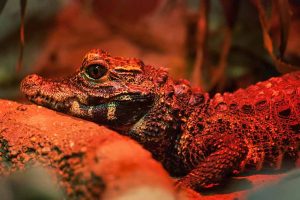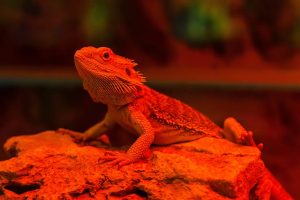
Some lamps or lamp combinations must be classified as harmful to health for reptiles. These include above all red light lamps and ceramic heaters.
Reptiles need a sufficient amount of light, heat and UV radiation. To survive in the terrarium. For this purpose, as a rule, a plurality of radiators are combined with one another in such a way that they complement each other in terms of their light spectrum. Ideally, light, heat and UV radiation In the right, i. Appropriate relationship. If this is not achieved sufficiently, injuries or illnesses can result.
A protection system is tricked
A special source of danger are red light bulbs and ceramic heaters. Since they do not emit any visible light (ceramic radiators) or only red light (red light), they are often used as a nightly heat source.
However, this is exactly the problem: In nature does heat come without Daylight share only as residual heat, e.g. In the form of heated rock. Under natural conditions, the residual heat decreases slowly and continuously at night when there is no solar radiation. Artificial heat sources, on the other hand, maintain their temperatures and irritate the temperature processing system of the Combustion, especially in snakes.

This danger can be reliably avoided by combining ceramic lamps and red light lamps with sufficiently strong light beams. Here, the temperature processing system reverts, because the existing heat is now interpreted as solar radiation – and in case of excessive sun radiation threatens to experience..This situation is known to the temperature processing system and can react accordingly.
Heating coil, heating mats, heating stones
The above also applies to heating mats, heating coils and heating blocks. In addition, they become very hot. Temperatures above 50 ° C are often reached during extended periods of operation. Various deserts, e.g. Bartagamen, however, do not tolerate such soil temperatures, rainforest inhabitants or nocturnal snakes. For the latter, most heating mats, heating coils and heartstones are too hot.
This problem can be solved relatively easily. For example, To limit the temperature of a heating element to approximately 40 ° C., a thermostat or, alternatively, a digital timer which switches on and off in a regular cycle, e.g. Switch on for 10 minutes, switch off for 30 minutes.
The same applies to heating mats, heating coils and heating elements: If possible, they should only be used in combination with light radiation!

Tips on the use of infrared heating systems and heat lamps
If possible, heat should always be combined with light radiation so that the temperature processing system of the animals is not irritated.
Around combustion must be equipped with a protective basket, red light bulbs and ceramic radiators. In addition, an irradiation temperature of not more than 40 ° C should not be exceeded – except for some deserts.
The heat generation of heating mats, coils and blocks should be limited to a maximum of 40 ° C by using a thermostat (except some deserts). Alternatively, a digital time switch is suitable, which switches on and off in a regular cycle, that is to say e.g. 10 minutes and turns off for 30 minutes.
During the day, heat lamps, heating mats and heating stones can also be operated at higher temperatures – but then only in combination with strong light, e.g. Together with HQI UV emitters (e.g., Lucky Reptile Bright Sun UV).
Heating mats and heating coils should be installed so that they can not be reached by digging reptiles or their burrowing (mice, rats). Otherwise threaten Burns and electrical shocks.
Heaters heated by heaters offer natural conditions. However, the stones should be large enough to store heat for a reasonable period of time. Dark stones heat up more strongly than bright, but can u.U. also combustion.
Even with the use of aquarium heating rods can it
Combustion come. Therefore, use the plastic protective grilles, which are usually supplied.
Translation Heike Krüger, edit www.terraristik.cz